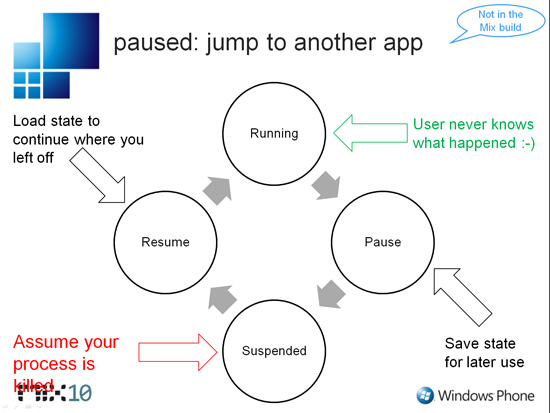Windows Phone 7: The AnandTech Guide
by Brian Klug on March 21, 2010 12:00 AM EST- Posted in
- Smartphones
- Windows Phone 7
- Mobile
Platform Architecture, Multitasking, and User Experience
There's a bit of confusion circulating around what form background processing or "multitasking" exists in on Phone 7 Series. A distinction needs to be made about multitasking at the OS level, background processing from the point of view of a standard marketplace-installed application, and multitasking as presented to the end user. To fully understand the situation, we need to talk about the software architecture. Let's dive into the details.
In the new-age of smartphone operating systems, WP7S' software architecture is completely unfamiliar. This is the managed, sandboxed architecture common to both iPhone OS and Android thus far. Gone are the close to metal compiled executables known to Windows Mobile developers. This time, virtually every experience runs atop either Silverlight or XML frameworks, or as HTML/JavaScript in the browser (though web-applications are still largely a cop-out).

WP7S' Software Architecture
First off, WP7S itself is a fully fledged multitasking operating system. Applications are called "sessions," and inside each session are other processes, called "pages." WP7S uses a state-based model to allow pages to be restored to the state they were at previously. When you leave a particular page or session, WP7S generally leaves the process running, until the dominant page with focus requests resources that require the old page to be terminated. At this point, the state of the prior page is saved temporarily. This process is called "dehydrating" the application. When you return, the page is "rehydrated" with the state data from before, allowing you to return:

The infamous slide illustrating state-saving, and suspended process killing
But the other side of the story is that a select number of first-party applications are allowed to be persistent, and truly run in the background. These are specific use scenarios that have been highlighted which Microsoft believes make sense. Those include loading a website in the background, playing music from the first party Zune music player, and allowing the phone to continue in the background. Other third-party applications, however, can be killed after suspension.
So the WP7S platform itself supports simultaneous process multitasking, but not for marketplace-installed third party applications. It's as simple as Charlie Kindel put it, "in this release, you cannot write code that will run in the background." So although multitasking is there, it isn't something that will be made accessable to third party developers. If you don't believe me, check out this demo screenshot from Istvan Cseri's awesome WP7S architecture deep dive presentation:

Two sessions, three pages, all running. Multitasking is there, you just can't use it. Yet.
It's even more compelling to see it in real time:
I asked Istvan after his demonstration flat-out whether there was any way that third party devs could enable multitasking for their programs. Be that setting a flag for persistent background execution, obtaining certification through additional marketplace vetting, or a lightweight executable. Pandora has become the perfect example of the kind of multitasking users pine for; streaming radio running in the background, with the same persistence as the first-party music player. I asked whether this use scenario would be possible on the WP7S platform scheduled for release holiday 2010. The answer was as clear as it was disappointing: no.
So you're probably wondering, why can't third party developers write applications that run persistently in the background? For now, it's because Microsoft isn't sure how to allow it without the potential for battery-draining to happen. Power users like AnandTech readers are able to make the distinction between a dead battery caused by the platform being poorly written, and poor battery life caused by running an application in the background. But ultimately, Microsoft is worried that your average end user won't see the distinction, instead faulting the entire platform as having poor battery life and power management.
Charlie Kindel, Microsoft's leading Windows Phone 7 Series evangelist, shared an anecdote several times about how a leading competitor's phone allowed for implicit multitasking (leaving applications running unless explicitly closed) which led to a poor end user experience, and dead battery for his daughter.
If you've ever used a Windows Mobile phone, you're probably completely familiar with that scenario. And it goes beyond just battery life; there's also the question of how best to allocate resources when other things are using CPU cycles and memory in the background. That kind of gradually-degrading performance is another Windows Mobile-ism Microsoft is dead serious about not letting happen. There's also the fact that existing SoCs are barely powerful enough to make running a single application feel quick. It won't be until we get multicore Cortex A9 or Intel Moorestown class hardware before we have the horsepower to multitask without a tangible performance impact.
I pitched an idea to Andre that he seemed receptive to while we talked about the reaction tech community had to the no third party multitasking announcement. As it stands now, multitasking isn't being included almost entirely as a design decision; Microsoft wants to get it right the first time so that the end user, out-of-box experience isn't like the one Charlie Kindel's daughter had. Its concern is that the lowest common denominator of users will attribute the rapid decrease in battery life to a platform or hardware problem, not just the sad reality of how quickly constant radio traffic and access to the audio stack can drain the battery.
What I argued is that users need to be empowered to make the decision between unitasking and multitasking themselves. They need a clear and obvious visualization about what the current power demands on the hardware are, and a prediction of how long the device will last based on that current use scenario. The analogous comparison is so obvious, I'm surprised nobody has made it yet: the laptop. For years now, users have been given direct control over whether they want to sacrifice battery life for performance, or performance for battery life. The obvious next step is to both extend this profile-based decision making to the mobile phone, and the problem will solve itself. I argue that if notebook users can do it and fully comprehend it, mobile phone users can as well.
Users already are forced to shape their expectations for both call quality and data throughput based on cellular signal visualizations (a far more nebulous metric than an unambiguous power report from the hardware). I argued that this same visualization and feedback should be passed onto the user for battery life and power draw so they can shape expectations and make decisions about what's best for them. Andre said he'd pass my thoughts on. It could be that this generation of ARM hardware doesn't have the metal taped-out to report power use in realtime, but in time, its offerings (and offerings from intel) must. Even then, it isn't as simple as enabling power reporting on the SoC, carriers think they know what's best for the user and are eager to value-add with their own performance and battery targets. It will be an uphill battle to wrangle control out of their hands, and into users'.










55 Comments
View All Comments
PsychoPif - Monday, March 22, 2010 - link
MS will push the upgrades, not the carriers.shady28 - Sunday, March 21, 2010 - link
Wow, you know there are (were) really only 5 platforms in the smartphone space - Windows Mobile, Palm WebOS, Blackberry RIM, iPhone, and Android. All of them were unique in their own way and had their own 'fanbase'.
Now MS has removed their uniqueness. Rather than improving on WinMo, they've decided to try to go head to head against the iPhone by attempting to match up against the iPhone's strengths (ie, interface, ease of use, MP3 player integration, app store, etc).
Naturally they've failed to best the iPhone in those categories by a long shot. Instead they essentially have made a device that is 'less than an iPhone' rather than a better WinMO device. I'd say this is the move that will kill off WinMo.
Johnmcl7 - Sunday, March 21, 2010 - link
Whatever you think of S60 and Maemo, Nokia still have a large share of the smartphone marketAzsen - Sunday, March 21, 2010 - link
Does Microsoft seriously think that home screen user interface looks good? It looks flippen hideous!! Give me iPhone UI any day.straubs - Monday, March 22, 2010 - link
No kiddding! Look at the Pre and then look at WP7S and tell me that doesn't look like something someone drew up in their basement in 1978. The single color and square corners are awful, not too mention huge amounts of wasted space everywhere.melgross - Sunday, March 21, 2010 - link
One thing that wasn't clear to me is whether or not music and books will be available without going through the marketplace. Apps can only be gotten there, so ok. The same thing is true for my iPhone. But I can get books, video and music onto the phone that weren't bought through the App Store or iTunes. Would that be possible here as well?The article didn't touch on that from what I saw. Anyone know?
nerdtalker - Sunday, March 21, 2010 - link
I touched on it, but only very briefly ;) partly because it's, you guessed it, not totally finalized. Microsoft wants everything to go through the marketplace, so that means yes, music, videos, and games are all marketplace purchases.A lot of developers were asking whether there was any API for them to do in-application commerce, and the answer was that this was still being worked on. Think the same way you can buy additional levels or addons in-game on the iPhone that are billed through the App Store. It isn't present in the builds of WP7S - yet.
It's another one of those things they haven't fully fleshed out yet, and haven't decided whether they can finish in time for release.
I didn't hear any mention of books at all, that's a great point. I'm not sure whether there's any strategy there.
Cheers,
Brian
CSMR - Sunday, March 21, 2010 - link
It looks like there is some complex sync process to transfer special types of file.You can't just plug in the phone, open it up as a storage device and drag files to and fro, as you can now.
Instead you probably need to install special sync software.
My advice: avoid and get a phone that is recognized as a storage device and has a usable file system.
MGSsancho - Monday, March 22, 2010 - link
Maybe it behaves like my ZuneHD. i just put music and audio books into my music folder and videos into my video folder. then it shows up in the Zune app. if i want to auto sync pics, vids, podcats and music it can or I can manually drag stuff the the ZuneHD device icon. oh you can either encode videos yourself or the app will do it for youMrPIppy - Sunday, March 21, 2010 - link
iPhone apps are sandboxed, but they are *not* managed code. Objective-C is compiled into ARM binaries, and garbage collection is not available on iPhone.